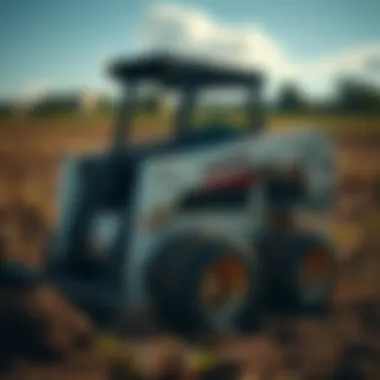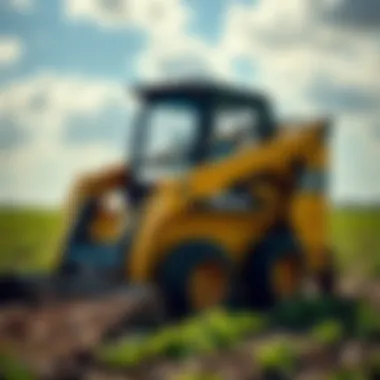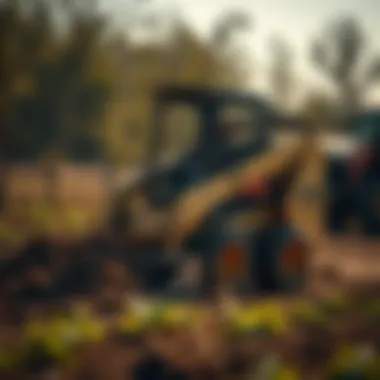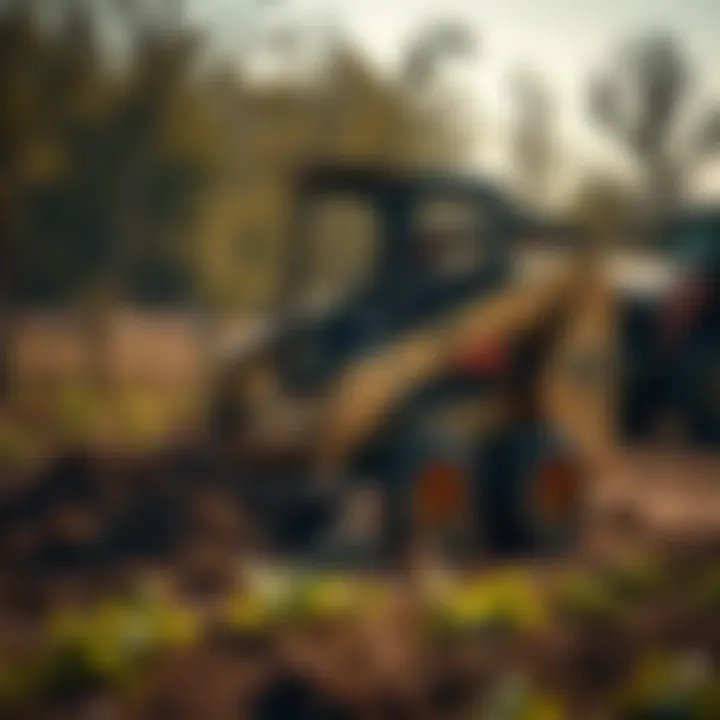The Role of Skid Steers in Modern Farming Techniques


Intro
In the realm of modern agriculture, the skid steer has emerged as a pivotal player, embraced for its multifaceted applications and operational flexibility. A skid steer, compact yet powerful, is increasingly becoming a staple on farms, whether they’re small family-run operations or expansive commercial enterprises. This intricately designed machine is designed for various tasks, from digging to lifting, making it a versatile asset for farmers striving to enhance productivity and efficiency.
Farmers today face a multitude of challenges, ranging from labor shortages to fluctuating market demands. In this context, skid steers have found their place, contributing significantly to the mechanization of agricultural processes while optimizing labor costs. With various attachments available, these vehicles can perform a myriad of jobs, ensuring that farmers can adapt to ever-changing agricultural landscapes.
This article will explore numerous aspects of skid steers, from their mechanics to practical applications in fields and orchards. We will delve into specific attachments that enable these machines to tackle diverse agricultural tasks, examine maintenance strategies essential for longevity, and highlight technological advancements shaping the future of skid steer operations in agri-industry.
The subsequent sections aim to showcase the transformational impact skid steers have on farming, offering insights tailored for agricultural professionals, enthusiasts, and anyone involved in agronomy.
Prologue to Skid Steer Technology
In the world of modern agriculture, skid steers have emerged as a game changer. Their versatility and compact size, coupled with a powerful suite of attachments, allow farmers to tackle a multitude of tasks efficiently. This section will provide a thorough understanding of skid steer technology, exploring its definition, overview, and historical evolution.
Definition and Overview
Skid steers are small, maneuverable machines with wheels or tracks that rotate independently, allowing for a zero-turn radius. This design grants them unparalleled agility, especially in tight spaces found on farms. Their capability to accept various attachments—from buckets to specialized gardening tools—makes them incredibly adaptable. By mixing power with portability, skid steers provide solutions to numerous farming challenges, making them indispensable in today's agricultural landscape.
Notably, their flexibility extends beyond agriculture; these machines find their footing in construction, landscaping, and snow clearing as well. Their compact size and ability to fit into hard-to-reach areas elevate their desirability for all sorts of outdoor projects. Furthermore, with attachments available for almost every conceivable task, farmers can convert one machine to meet various needs throughout the seasons, which, in turn, enhances productivity and reduces the need for multiple machines.
History of Skid Steers
The concept of skid steer technology dates back to the late 1950s, originating in the construction realm before its transition into agricultural use. The first skid steer, designed by the Keller brothers in Minnesota, was intended for farm purposes; it was a compact loader that helped solve challenging tasks like moving hay bales or clearing debris.
As the years rolled on, manufacturers such as Bobcat and Case made significant advancements to the design, enhancing the performance and versatility. The addition of hydraulic systems allowed for increased lift and power, transforming how farmers approached everyday chores. By the 1980s and 90s, skid steers had become a staple on farms across the United States, breaking ground in what was once thought possible with compact machinery.
Today, the evolution of skid steers continues as they embrace the advent of technology, including automation and GPS integration, but their core utility remains intact. It’s fascinating how a machine once limited to feel like a luxury has now found its way into the everyday toolkit of farmers. With this rich history, it’s clear these machines aren’t just tools—they're integral partners in modern agricultural operations.
Mechanics of Skid Steers
Understanding the mechanics of skid steers is crucial for anyone involved in modern agriculture. These compact machines have revolutionized various farming practices by enhancing efficiency and versatility. A skid steer operates based on innovative designs that allow it to perform multiple tasks within limited spaces, making it invaluable in crop production and management. The following sections delve into how they work and what key components enable them to meet the diverse needs of agriculture today.
How They Work
A skid steer functions through a unique system of steering and propulsion. Unlike traditional vehicles that use a steering wheel, skid steers rely on individual wheel control. That means each side of the machine can move independently – like a dance where one foot steps left while the other glides right. This allows for tight turns and agile movement, essential in navigating through rows of crops or maneuvering around obstacles in a field.
The principle behind a skid steer’s movement is called "skid steering." This method creates a pivot point, enabling the machine to rotate around a center. When one side moves faster than the other, the skid steer turns toward the slower side. It's efficient and simplifies operations. However, frequent use on soft or uneven terrain can lead to increased soil compaction, which is an important consideration for farmers.
Key Components
Every skid steer consists of vital components that contribute to its performance. Understanding these parts highlights why skid steers are a go-to equipment for many in agriculture.
Engine
The engine is the heart of any skid steer. Generally, these machines are equipped with diesel engines, known for their fuel efficiency and torque. A robust engine ensures that the skid steer can handle various tasks, from lifting heavy loads to performing rapid maneuvers. The typical feature of these engines is their power-to-weight ratio, which enables them to deliver high levels of performance without sacrificing fuel economy.
One unique aspect is their adaptation to different applications. Some engines are designed to minimize emissions, making them a popular choice for environmentally-conscious farmers. However, maintenance must be regular; neglect can lead to fewer gains in efficiency over time.
Drivetrain
The drivetrain of a skid steer is responsible for translating the engine's power into movement. Essentially, it connects the engine to the wheels, ensuring that every bit of energy produced is used efficiently. A significant characteristic of the drivetrain is its simplicity – fewer moving parts mean lower chances of breakdown.
Another unique feature is the use of hydrostatic systems in many models, allowing for smooth acceleration and better control of speed. This can be a huge advantage when working in delicate situations like around seedlings. On the downside, repairs can be costly if the system fails, so it's wise to keep an eye on it during routine maintenance.
Hydraulics
Hydraulics play a pivotal role in enhancing a skid steer's capabilities. They control attachments, from buckets to pallet forks, allowing them to lift and move heavy materials effectively. The key characteristic here is the speed and precision that hydraulic systems provide, making tasks like loading grain or clearing debris almost effortless.
What’s even more interesting is that the hydraulic systems in skid steers are often diagnostics-friendly, meaning operators can troubleshoot issues before they escalate. However, they do require an understanding of fluid levels and potential leaks. A minor oversight can lead to inefficiencies, making training essential for operators.
The mechanics of skid steers, highlighted by their innovative engine, dependable drivetrain, and powerful hydraulics, serve as a foundation for their application in agriculture. By grasping these components, farmers and agricultural enthusiasts can appreciate how these machines not only ease workloads but also contribute to effective resource management in the field.
Applications of Skid Steers in Agriculture
The application of skid steers in agriculture plays a pivotal role in the contemporary agricultural landscape. Their versatility allows farmers to tackle diverse tasks more efficiently and effectively. This section explores how skid steers have revolutionized practices in land preparation, material handling, crop maintenance, and landscape management. These machines, fitted with a variety of attachments, enhance productivity and reduce labor demands, making them indispensable in today’s farming operations.


Land Preparation
Land preparation is a vital phase in agriculture, laying the groundwork for successful crop production. Skid steers streamline this process dramatically. Their compact size enables them to operate in tight spaces, navigating fields with ease where larger machinery might falter. Farmers can utilize skid steers for tasks such as tilling, leveling, and clearing land.
The use of specific attachments like tiller implements turns skid steers into powerful tools for soil preparation. This allows for rapid and efficient mixing of soil and nutrients, setting the stage for healthier crops. Moreover, utilizing skid steers in land preparation enhances the timeliness of operations, thereby maximizing potential yields. The adaptability to various terrains ensures that farmers can maintain productivity across diverse agricultural settings, proving that skid steers are indeed a farmer's best friend.
Material Handling
Material handling encompasses various activities essential for keeping agricultural operations running smoothly. Skid steers excel in this capacity, being able to load, unload, and transport materials with remarkable agility.
Loading and Unloading
Loading and unloading are critical processes that significantly influence the overall efficiency of farm operations. Skid steers equipped with specialized buckets facilitate quick loading of bulk materials, such as grain or fertilizer. This contributes to minimizing downtime during critical periods, particularly during planting or harvesting seasons.
One standout characteristic of this function is the swift operational capability of skid steers. They can quickly scoop materials into trucks or carts, offering farmers a reliable solution when time is of the essence. This efficiency often translates to labor cost savings, as fewer operators are needed to manage these processes. However, one must be cautious with weight limits to avoid overloading, which could lead to mechanical issues over time.
Transporting Resources
Transporting resources, whether it’s equipment or harvested crops, is another vital aspect of agricultural operations. Skid steers shine in these tasks due to their maneuverability. They can traverse uneven terrains, ensuring that resources reach their destination without damaging the crops or the soil.
The key advantage here lies in their ability to transport materials efficiently over short distances, something that larger vehicles may struggle with due to their size. Moreover, skid steers can be fitted with forks or flatbeds, expanding their functionality for different transport needs. However, one consideration is the need to manage fuel consumption effectively, as frequent use can lead to costly operational expenses.
Crop Maintenance
Crop maintenance tasks are numerous and often labor-intensive. Skid steers lighten this burden by enabling farmers to perform various maintenance activities with ease. From mowing to spraying, these machines can be outfitted with specialized attachments that suit specific maintenance needs. This adaptability not only saves time but also enhances the quality of crop care, leading to better yields and healthier plants.
Landscape Management
In landscape management, skid steers play a crucial role in enhancing the aesthetic aspects of agricultural land. Whether it's clearing debris, grading, or creating pathways, skid steers provide the necessary power and versatility. By effectively managing the terrain surrounding fields, farmers can improve drainage and accessibility, which contributes to the overall health of the agricultural ecosystem.
In summary, the applications of skid steers in agriculture are diverse and significant. They empower farmers by streamlining various agricultural processes, allowing for increased productivity and improved operational efficiency. As agriculture continues to evolve, so too will the role and function of these remarkable machines.
Types of Skid Steer Attachments
The adaptability of skid steers in agriculture will not reach its full potential without considering the different attachments available. Each type adds a layer of versatility that can simplify operations and enhance productivity on the farm. Understanding the various skid steer attachments is crucial for farmers looking to optimize their equipment for specific tasks. This section highlights significant attachments, their unique benefits, and what farmers need to consider when choosing the right tool for the job.
Buckets and Attachments
Buckets are perhaps the most common attachment for skid steers and play a vital role in many agricultural tasks. They are primarily used for loading and transporting materials such as soil, gravel, or feed. The design of the bucket can vary significantly, offering options like:
- Standard Buckets: Perfect for excavation and material handling.
- High-Volume Buckets: Ideal for transporting large quantities quickly, which means less time spent making trips.
- Angled Buckets: Helpful in grading or moving material more efficiently through direct manipulation.
Using buckets increases efficiency during feed handling or land clearing tasks. Since many agricultural tasks require repeated loading and unloading, the right bucket can make all the difference in productivity. Plus, using durable materials ensures these attachments stand the test of time.
Mowers and Brush Cutters
Farm maintenance isn't just about crops; it also involves managing overgrowth and maintaining open spaces. Mowers and brush cutters are essential skid steer attachments for keeping fields, pastures, and roadsides in check. The key characteristics of these attachments include retractable blades and adjustable heights, making them versatile for different cutting needs.
When a farmer needs to clear brush or maintain pasture boundaries, these attachments provide an effective solution. Moreover, the ability to attach them quickly allows for seamless transitions between tasks. However, users must ensure that they select the right cutting width and blade type according to their specific environments to maximize effectiveness.
Forks and Pallet Lifters
Sometimes, the most basic tasks can become the most pivotal. This is where forks and pallet lifters come into play. These attachments turn a skid steer into an even more capable machine, allowing farmers to handle heavy pallets or stack loads with ease. Their primary advantage lies in promoting safety by reducing the risk of injury from manually lifting heavy items.
When utilizing forks, farmers must pay attention to the weight limits and ensure their skid steer retains adequate balance. Every agricultural operation can benefit from adding forks for loading bales or transporting materials, proving that minimal but effective solutions often yield the best results.
Specialized Attachments
Specialized attachments elevate the capabilities of skid steers even further, catering to more specific agricultural needs. Their ability to tackle unique tasks can save resources and significantly enhance operational efficiency.
Snow Removal
Dealing with winter weather can be a headache for farmers. Snow removal attachments, designed for skid steers, can promptly clear pathways, barnyards, and access roads. One key characteristic of these attachments is their expansive width, which allows them to clear large areas swiftly. This makes them invaluable during harsh winters.
Snow removal tools are popular choices because they combine power with efficiency. The blade's angle can be adjusted easily, ensuring thorough clearing without the need for excessive maneuvering of the skid steer. Additionally, pairing this with a front-mounted attachment creates an even more productive setup by allowing two tasks at once—removing snow and enabling easier travel for other machinery.
However, keeping in mind the potential for damage during operation (if not managed correctly) is essential. Users need to focus on careful navigation of uneven terrain to prevent risk of tipping over or excessive wear on the attachment.


Ditching
Another specialized attachment worth considering is a ditching bucket. These attachments help create and maintain ditches, which are crucial for effective drainage. They are particularly useful in agricultural settings where spatial water management is essential.
The unique feature of ditching buckets is their shape, specifically designed for cutting and removing material while simultaneously shaping the ditch. This makes it a beneficial tool for farmers needing to control water flow or prevent flooding.
While ditching can be a labor-intensive process, using a skid steer with the right attachment streamlines this task. One of the considerations, however, is ensuring the skid steer is on stable ground to avoid any unwanted risk during operation. This ensures that the benefits of drainage management lead to better productivity across the farm.
In summary, understanding the available skid steer attachments is critical for optimizing agricultural productivity. These tools transform the way farm tasks are accomplished, enhancing safety while maximizing efficiency. The variability of tasks covered by the right attachments makes them an indispensable part of modern agriculture.
Operational Efficiency of Skid Steers
In agriculture, efficiency can sometimes be the fine line between profit and loss. The operational efficiency of skid steers represents an essential topic for farmers looking to maximize their agricultural operations. This machine's multifaceted capabilities—ranging from land preparation to maintenance tasks—can not only save farmers time and resources but also significantly enhance productivity.
Increasing Productivity
One of the key benefits of using skid steers is their unparalleled ability to boost productivity on the farm. Instead of laboring through longer hours with traditional equipment or manual methods, farmers can tackle more tasks in less time. Consider a scenario where a farmer needs to clear land for planting. A skid steer equipped with a brush cutter can tackle thick underbrush rapidly. This efficiency means farmers can transition quickly from one task to another, potentially increasing the number of crops they can plant in a season.
Furthermore, the versatility of skid steers allows them to pick up various attachments tailored for specific tasks. For instance, using a bucket attachment for digging and scooping is common; however, when combined with specialized tools for planting or fertilizing, farmers can streamline their workflows dramatically. The reality is that higher productivity doesn't just equate to more work done; it can translate into enhanced crop yields, creating a sustainable competitive edge in an industry where every advantage counts.
"The performance of skid steers revolutionizes farm operations, allowing for speed and flexibility that traditional methods cannot match."
Time and Labor Savings
Time is money, especially on a farm where seasons dictate the pace of work. Skid steers can dramatically cut down on the amount of labor needed for various tasks. When harvesting, for example, instead of employing a small army of workers with shovels or hand tools, a skid steer can quickly load crops onto transport vehicles. This dramatic reduction in labor not only conserves effort but also reduces costs associated with hiring seasonal workers.
Moreover, these machines are designed to operate efficiently in tight spaces, which is particularly valuable when it comes to smaller plots of land or crowded farmyards. They can maneuver where larger equipment might struggle or even be unable to fit, ensuring that no time is wasted moving materials or equipment around.
To put it simply, the time savings multiplier effect that skid steers offer extends beyond just the direct time saved on each task. When farmers can finish tasks quicker, they can dedicate those precious hours to activities that offer the chance for additional revenue or better crop management practices.
Maintenance Considerations
Understanding the maintenance of skid steers is crucial for maximizing their operational lifespan and effectiveness in agricultural applications. Proper maintenance not only enhances performance but also ensures the safety of operators and those in proximity. When farmers take a proactive approach to upkeep, the benefits manifest not just in machinery performance but in overall productivity on the field.
Through meticulous routine practices, farmers can mitigate potential malfunctions, thus avoiding costly downtimes during critical farming seasons. Being aware of common issues and knowing how to troubleshoot them enables operators to address matters promptly, preventing small problems from snowballing into larger, more complex issues.
"A stitch in time saves nine"—this old saying rings particularly true for machinery maintenance; regular attention today can prevent major repairs tomorrow.
Routine Maintenance Practices
Routine maintenance practices are the bedrock of reliable skid steer operations. Regularly scheduled checks can significantly prolong the life of these versatile machines. Farmers should focus on the following key areas:
- Engine Checks: Regular oil changes and air filter replacements are vital. Parameters like engine temperature and fluid levels should be monitored often.
- Hydraulic System Maintenance: Check hoses and connections for leaks or wear. Maintaining hydraulic fluid levels ensures optimal performance.
- Tire and Track Inspections: Look for signs of wear, inflation levels, and ensure the tread is in good condition. This affects traction and ground stability, especially in varied terrains.
- Greasing and Lubrication: Keeping moving parts well-greased reduces friction and wear, enhancing the machine's efficiency and functionality.
Additionally, keeping a maintenance log is helpful. It not only tracks performed services but also identifies patterns that might hint at underlying issues.
Troubleshooting Common Issues
No piece of machinery is without its quirks and challenges, and skid steers are no exception. Knowledge of common problems can often save the day.
- Starting Issues: If the engine refuses to start, check the battery connections and fuses. Also, ensure there’s sufficient fuel in the tank.
- Unresponsive Hydraulics: If hydraulic functions are sluggish, check the fluid levels and look for contamination or air leaks in the hydraulic lines.
- Overheating: Regularly check the radiator and coolant levels. Debris may block airflow, so keeping these areas clean is essential.
- Tire Problems: Uneven wear or punctures can lead to poor performance. Ensuring proper inflation and immediate repairs can avoid more significant challenges.
Incorporating these maintenance practices and troubleshooting tips creates a safety net for the machinery, promoting not just productivity but also safety for those working around and with the skid steers. This foresight helps farmers stay ahead of the game—turning potential misfortunes into mere bumps in their agricultural journey.
For more detailed guidelines, consider visiting resources like Wikipedia on Skid Steers and USDA guidance on machinery.
Environmental Impact of Skid Steers
The role of skid steers in modern agriculture extends far beyond mere productivity; they carry significant environmental implications as well. Understanding how these machines interact with nature can lend insights about sustainable farming practices. Skid steers are not just powerful workhorses; their operational characteristics can either mitigate or exacerbate environmental challenges faced by farmers today. The balance of pursuing agricultural efficiency while being mindful of the environment is a tightrope that needs careful navigation. This section aims to delineate the environmental considerations revolving around skid steer utilization.
Fuel Efficiency
Fuel efficiency is a critical element in determining the environmental impact of any machinery, and skid steers are no exception. It is a known fact that these machines are designed with modern engines and advanced technology that prioritize fuel economy. This efficiency not only translates to cost savings for farmers but in essence, it also means reduced greenhouse gas emissions. Skid steers equipped with fuel-efficient engines can provide substantial performance without guzzling resources like a thirsty plant.
Many manufacturers are focusing on eco-friendly design, with machines that comply with stringent emissions regulations. By opting for energy-efficient models, farmers can significantly lower their environmental footprint. Additionally, improvements in hydraulic systems have led to better fuel consumption rates, making contemporary skid steers more efficient than their predecessors.
Some tips farmers can consider to enhance fuel efficiency include:


- Regular maintenance checks for engine health
- Proper operator training on load management
- Use of appropriate attachments for specific tasks
"The efficiency of skid steers goes beyond productivity; it's a necessary step towards sustainable agriculture."
Reducing Soil Compaction
Soil compaction is often an overlooked issue in agricultural practices. When heavier machinery traverses a field, it can compress the soil structure, leading to a host of problems that affect crop yield and health. Skid steers, however, have certain advantages that can help alleviate soil compaction concerns. Their smaller wheelbase or track systems can navigate tighter areas with lesser ground pressure than traditional tractors, minimizing surface disruption.
Using a skid steer can allowfor versatile maneuvering around crop rows and sensitive areas, hence preserving soil integrity. It is evident that a lower overall seasonal pressure on soil contributes positively to its health.
To minimize soil compaction, farmers might consider the following strategies while using skid steers:
- Select lighter-weight attachments rather than heavy ones
- Schedule operations when the soil is dry to maintain structure
- Rotate among fields to let compacted areas recover
In summary, the environmental impact of skid steers in agriculture is a nuanced subject that showcases both their potential and responsibilities. With thoughtful operation and maintenance, farmers can harness the capabilities of skid steers while contributing to sustainable agricultural practices.
Technological Advancements
In the ever-evolving landscape of modern agriculture, technological advancements play a significant role in enhancing operational efficiency. Specifically, advancements in skid steer technology are revolutionizing farming practices, making tasks easier, faster, and more precise. This section delves into two pivotal aspects of these technological marvels: automation and robotics, as well as GPS integration.
Automation and Robotics
The integration of automation and robotics in skid steer operations is no small feat. These technologies have transitioned from futuristic concepts to practical agronomy tools. With the ability to perform tasks autonomously, skid steers equipped with robotic functions significantly reduce manual labor, allowing farmers to focus on more critical aspects of their business. For instance, a farmer can set a skid steer to execute repetitive tasks like loading bales or spreading mulch without constant supervision. This not only saves time but also minimizes human error.
Moreover, automated features enhance safety in agricultural environments. By employing sensors and camera systems, these skid steers can navigate rough terrains and avoid obstacles, resulting in fewer accidents. The use of robotics means fewer physical demands placed upon workers, reducing the chances of fatigue or injury during long hours in the field. As technology continues to advance, one can expect to see even more sophisticated capabilities in skid steers, perhaps even beyond what we can currently conceive.
GPS Integration
Another crucial development is GPS integration, which has transformed how farmers utilize skid steers for a variety of tasks. By leveraging GPS technology, these machines can achieve unprecedented levels of precision in operations like planting, trenching, or leveling. This is particularly beneficial when it comes to tasks that require exact measurements, ensuring uniformity across agricultural plots.
With GPS systems, farmers can create detailed navigation routes for their skid steers, minimizing overlaps during tasks and reducing waste of resources. Additionally, the data collected through GPS helps in better farm planning and analysis. As farmers gain insights into field conditions and operational efficiency, they can make informed decisions on optimizing yields and resource management.
"Embracing technologies like automation and GPS can create not just efficiencies but also complete transformations in agriculture."
The implementation of these technologies proves not only to push the envelope on productivity but also to facilitate sustainable farming practices, minimizing environmental impact. Furthermore, as these technologies continue to improve, they are set to further cement their place within the agricultural sector, making it crucial for farmers and stakeholders to stay abreast of these changes.
Future Prospects for Skid Steers
The future of skid steers in agriculture is a subject imbued with potential and promise. As the agricultural landscape continues to evolve, driven by technological advancements and shifting economic conditions, the role of skid steers is expected to expand significantly. This section explores some noteworthy aspects of this evolving role, including emerging trends in agricultural equipment and indicators signaling market growth.
Trends in Agricultural Equipment
The agricultural equipment sector is witnessing a transformation, marked largely by the integration of smart technology into machinery. Skid steers are no strangers to this movement. For instance, the introduction of automated systems and enhanced electronics means that these machines are becoming smarter and more efficient in performing essential tasks. Here are some trends to keep an eye on:
- Automation: Increasingly, skid steers are integrating robotic systems that ease the operational burden on farmers, allowing them to maximize productivity without additional labor costs. Although automation in agriculture has met some skepticism, evidence suggests machinery equipped with automated features can significantly enhance productivity.
- Remote Control Capabilities: With technologies allowing operators to control their skid steers from a distance, farmers can now monitor and execute tasks without being physically present. This can be particularly useful during adverse weather conditions or when managing multiple operations simultaneously.
- Enhanced Connectivity: With the advent of IoT (Internet of Things), skid steers are connected to various sensors that gather essential data. This connectivity allows farmers to assess their land, manage resources efficiently, and maximize yields.
Investing in such technologies will not only enhance the utility of skid steers but also provide farmers with crucial insights and adaptability in an increasingly competitive market.
Market Growth Indicators
Several market growth indicators point to a promising future for skid steers in agriculture. These indicators are critical for stakeholders in the sector to understand the shifting dynamics and to anticipate potential economic impacts. Some key indicators include:
- Increased Demand for Efficient Machinery: Farmers are constantly seeking ways to enhance efficiency, reduce labor costs, and optimize outputs. The increasing need for compact, powerful, and versatile machinery aligns perfectly with what skid steers offer.
- Rising Investment in Agricultural Technology: Capital flow into agricultural technology is increasing, signaling a robust interest in innovating equipment trends. The market for advanced agricultural machinery is forecasted to grow steadily, benefiting skid steer manufacturers who are pivoting in line with current demands.
- Sustainability Focus: As environmental considerations become central in agricultural discussions, skid steers that reduce soil compaction and operate with greater fuel efficiency have a growing appeal. Equipment that is both environmentally friendly and technologically advanced will likely see increased demand in coming years.
"The future belongs to those who believe in the beauty of their dreams." This statement resonates well with farmers and stakeholders in agriculture, urging them to look ahead and embrace the innovations that skid steers and other modern equipment promise.
End
As we draw the curtain on the exploration of skid steers in modern agriculture, it's essential to reflect on how these machines have reshaped the landscape of farming practices today. The contribution of skid steers to agriculture cannot be overstated; they are the backbone that supports a multitude of tasks ranging from land preparation to crop maintenance. Farmers have steadily embraced their versatility, finding them indispensable for boosting efficiency and productivity.
Summarizing Key Insights
One key insight is the adaptability of skid steers to a variety of agricultural applications. These machines are not just powerful; they are equipped with a range of attachments that allow them to perform multiple tasks. For instance, a single skid steer can transition from loading bales of hay to clearing land with the simple switch of an attachment. This flexibility saves time and reduces the need for multiple pieces of equipment, ultimately cutting costs for farmers.
Moreover, skid steers inherently enable greater precision in farming operations. Whether it’s performing delicate tasks such as planting or heavier duties like transporting materials, their design aids in reducing human error and achieving better results. In addition, the maintenance routines that can be easily integrated into their operational cycle ensure long-term reliability, supporting farmers in their daily operations.
The Future Landscape of Skid Steers
Looking ahead, it’s fascinating to consider how the technological advancements will continue to mold the future of skid steers in agriculture. Automation and smart technology are set to enhance how these machines operate, making them even more efficient. The integration of GPS and robotics can lead to unparalleled precision in tasks, transforming not just how we farm, but what we consider to be possible.
Additionally, as climate change impacts food production globally, the role of skid steers could become even more significant. Their ability to reduce soil compaction while increasing the productivity of arable land will be crucial as we look for sustainable farming solutions.
In summary, as the agricultural sector evolves, so too will the capabilities and functionalities of skid steers. It's not just about what these machines can do today; it's also about the potential they have to adapt and meet the dynamic demands of tomorrow's agriculture. Farmers who recognize and harness this potential will likely find themselves at the forefront of the agricultural revolution.















